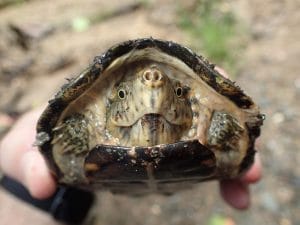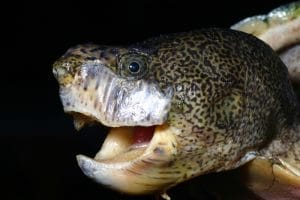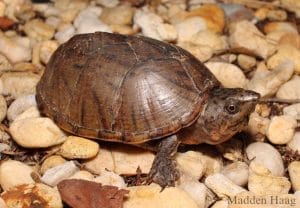Sternotherus odoratus (eastern musk turtle)
Home > Turtle Database > Sternotherus odoratus (eastern musk turtle)

Sternotherus odoratus, known as the eastern musk turtle, is a small aquatic turtle found in eastern North America. It’s famous for the strong, foul odor it releases when threatened, which led to its nickname “stinkpot.” This hardy species thrives in various freshwater habitats and is known for its secretive nature.
Native To These Regions
Alabama (USA), Arkansas (USA), Connecticut (USA), Delaware (USA), Florida (USA), Georgia (USA), Kentucky (USA), Louisiana (USA), Maine (USA), Maryland (USA), Massachusetts (USA), Mississippi (USA), Missouri (USA), New Hampshire (USA), New Jersey (USA), New York (USA), North Carolina (USA), Ontario (Canada), Pennsylvania (USA), Quebec (Canada), South Carolina (USA), Tennessee (USA), Texas (USA), Vermont (USA), Virginia (USA), West Virginia (USA)Native Turtle Species Map – Find Turtles by Region
Scientific Classification
Kingdom: Animalia
Phylum: Chordata
Class: Reptilia
Order: Testudines
Family: Kinosternidae
Genus: Sternotherus
Species: Sternotherus odoratus
Common Names
Eastern musk turtle
Stinkpot turtle
Common Musk turtle
This Hilarious Turtle Book Might Know Your Pet Better Than You Do
Let’s be real—most turtle care guides feel like reading a textbook written by a sleep-deprived zookeeper.
This one’s not that.
Told from the snarky point of view of a grumpy, judgmental turtle, 21 Turtle Truths You’ll Never Read in a Care Guide is packed with sarcasm, sass, and surprisingly useful insights.
And hey—you don’t have to commit to the whole thing just yet.
Grab 2 free truths from the ebook and get a taste of what your turtle really thinks about your setup, your food choices, and that weird plastic palm tree.
It’s funny, it’s honest, and if you’ve ever owned a turtle who glares at you like you’re the problem—you’ll feel seen.
Identification
Description
The eastern musk turtle has a dark brown to black domed carapace, often covered in algae. Its plastron is small, exposing much of its body. Its head is dark with two distinct pale or yellow stripes running from the nose to the neck. Adults usually grow between 3 to 5 inches.
Sexual Dimorphism
Males have longer tails with a sharp tip, and their vent is located farther down the tail. Females are slightly larger in body size but have shorter, less pronounced tails.
Check more turtles from the Sternotherus genus
Native Origin and Distribution
Geographical Range
The eastern musk turtle ranges across eastern North America, from southern Canada down to Florida and west to Texas and Wisconsin. It’s one of the most widespread musk turtles.
Preferred Habitat
This species prefers slow-moving, shallow water bodies like ponds, swamps, marshes, and sluggish streams. It often hides under submerged logs, rocks, or vegetation and prefers areas with muddy bottoms.
Behavior
Feeding Habits
The eastern musk turtle is omnivorous, feeding on aquatic insects, small crustaceans, mollusks, carrion, and plant material. It forages along the bottom, using its sharp jaws to handle tough prey.
Predators
Predators include large fish, wading birds, raccoons, and snakes. Hatchlings and juveniles are at higher risk due to their small size and softer shells.
Reproduction
Breeding Season
Mating usually happens in spring and fall, with females nesting in late spring and early summer.
Reproductive Method
Females lay clutches of 1 to 9 eggs in soft soil, leaf litter, or rotting logs near water. Eggs incubate for about 60 to 100 days before hatching.
Conservation
Extinction Status
The eastern musk turtle is currently listed as Least Concern due to its wide range and adaptability.
Threats
Habitat loss, water pollution, and road mortality are the biggest threats to local populations. Collection for the pet trade can also impact populations in some areas.
Conservation Measures
Protecting wetlands, reducing pollution, and limiting collection help support healthy populations. Education about wetland conservation also helps protect this species.
Economic Importance
The eastern musk turtle has moderate importance in the pet trade, where its small size and hardy nature make it appealing to hobbyists. In the wild, it helps control insect and snail populations, playing a role in keeping aquatic ecosystems balanced.
Interesting Facts
The eastern musk turtle can climb submerged branches and logs, sometimes even climbing out of the water into low vegetation.
It gets its nickname “stinkpot” from the strong, musky odor it releases from glands near its shell when disturbed.

About Author
Muntaseer Rahman started keeping pet turtles back in 2013. He also owns the largest Turtle & Tortoise Facebook community in Bangladesh. These days he is mostly active on Facebook.














